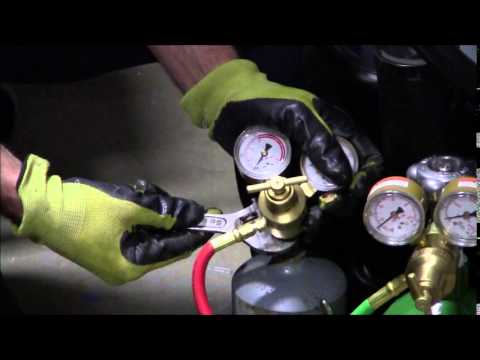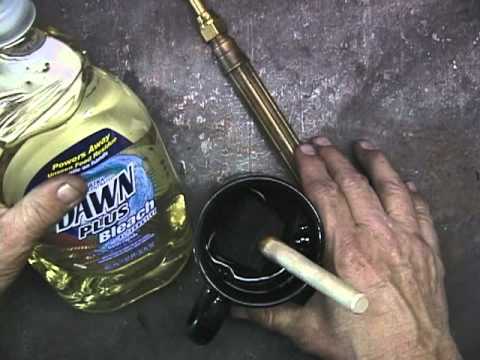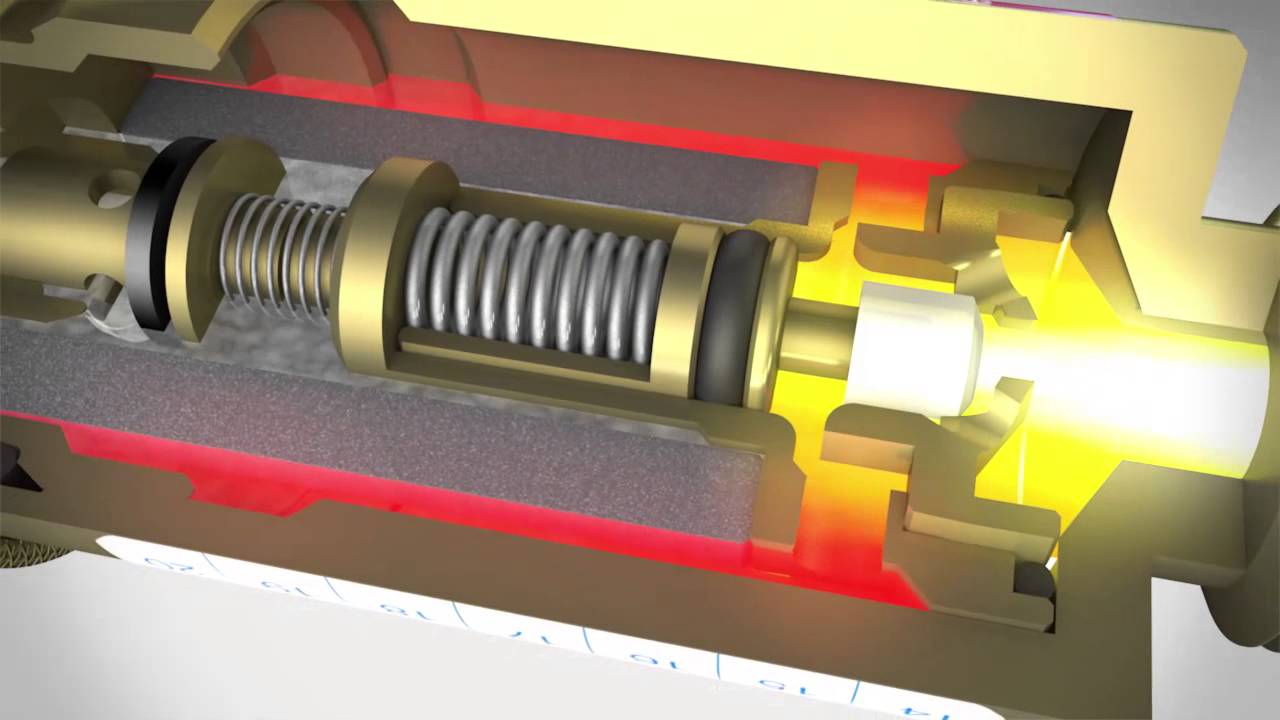Summary
These tips for proper fuel pressure regulator use should only be used for a general understanding.
Using, symptoms assessment or troubleshooting should only be done by experienced professions in consultation with the manufacturer’s directions and advice.
Failure to properly test and use equipment can result in injury, burns or harmful explosions.
For existing torch sets, start with a review of the testing procedures described at the bottom of this page to determine if the system is leak-free.
Both the acetylene (compound of carbon and hydrogen) and oxygen hoses and the system should be fully tested (when combined acetylene and oxygen is referred to as Oxyacetylene.)
In general, the more fittings you have, the more possible points where there can be a leak. If you are using a gas saver make sure it is closed when testing for leaks.
Keep all regulators free of grease, oil and flammable substances. All regulators are marked for the cylinder gas service for which that gas cylinder is designed (for example CGA 510 is for acetylene, propane and methyl acetylene). CGA 540 is for oxygen only.
Always have them serviced and repaired by a qualified technician.
Wear Kevlar gloves and safety glasses when setting up and testing any welding process.
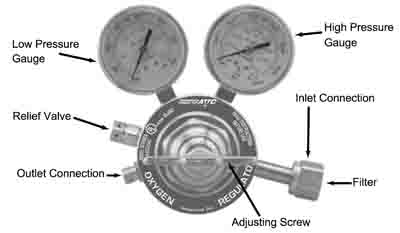
Also read: What Size Welding Gas Tank for MIG or TIG?
How to Setup the Fuel Pressure Regulator
Video: How to Set Up A Oxyacetylene Torch Set
Before you start, as a warning, the acetylene can’t be over 30 pounds (on most dials over 15 PSI “in the red”, it is usually around 5 for simple brazing projects). At levels over 15 PSI the oxyacetylene becomes unstable! Download the guide below and check page 45 for typical PSIG levels for oxygen and acetylene based on metal thickness.
Instructions for New Installations
Before starting the installation make sure to wear safety glasses and Kevlar gloves for safety.
- Give each gas tank a quick turn of the top value and “spurt” to clear any dust. Just a quick blow to clean it out.
- Take regulators and make sure that the Regulator Pressure Adjusting Screw is loose (valve at the center of the regulator as shown below). When the tension on the spring that controls the valve is released the regulator does not allow the flow of gas.
Make sure that the regulator has the correct pressure rating for the cylinder that you plan to use.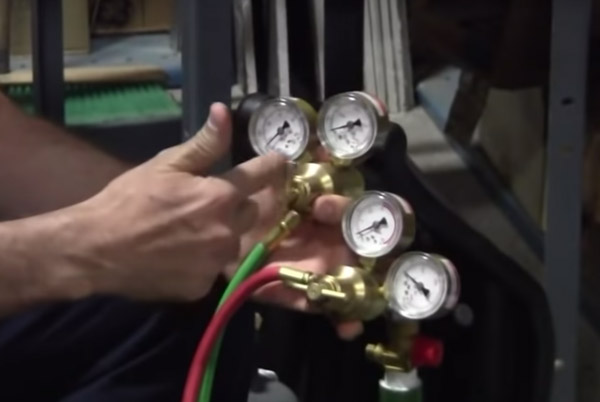
Before Installing Make Sure the Regulator is Loose, Has No Spring Tension 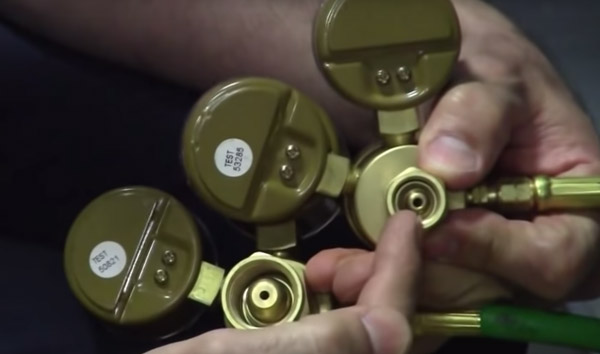
Fuel Hose Connections are Sized to the Different Tanks (Acetylene and Oxygen). Note that oxygen regulators have a right-hand threaded outlet to mate with right-hand hose connections. Fuel gas regulators are left-handed to mate with left-hand hose connections and have a “v” notch to further indicate that it is for fuel gas. - Attach the regulators to their respective gas (The red hose is acetylene and the green is oxygen). Each is sized as shown above to the correct gas bottle to avoid errors. Screw it on by hand at first and then tighten with a tool. First, start with the oxygen regulator and then move on to the oxyacetylene tank.
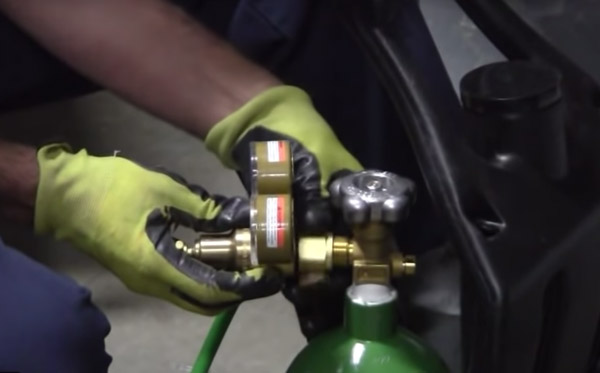
Tightening the Regulator Valve to the Oxygen Tank By Hand and Then With a Smooth Jaw Adjustable Wrench. Make Sure the Gauges are Level When Tightening – Make Fairly Tight - Close the control valves on the welding torch.
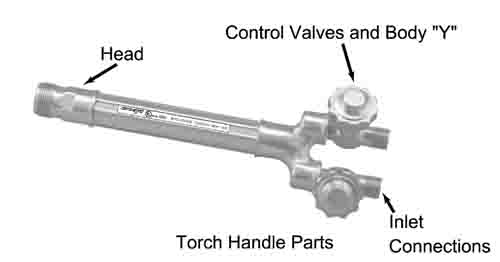
Welding Torch Handle - Open the oxygen (full open and then back off 1/2 turn) and acetylene valves (1 turn) on the tanks.
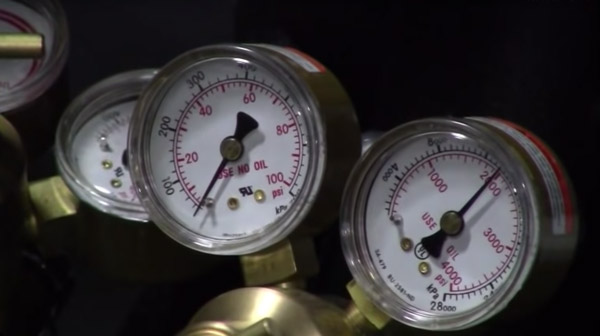
The red area of the gauge (inside numbers) are the PSI). As shown the oxygen gauge (right) has 2000 PSI. The regulator (left) has 0 since the spring on the center regulator know is loose. As you tighten it the PSI will start to rise on the left. - Check the valve on the right that measures the contents of each gas tank. That indicates the tank contents. Next, tighten the value at the center of the regulator. The oxygen should be tightened first to about 10 PSI. The acetylene is next and should be less than then oxygen, about 5 PSI. (an alternative is 7 PSI for the acetylene and 15 PSI for the oxygen). Check the manufacturer’s directions. One reason the acetylene is less is to prevent it from entering the oxygen tank. These levels should be adjusted so that they are maintained when welding and the torch are being used. Adjust the pressure value as needed.
- When lighting the torch, first open the acetylene valve and light. Now adjust the flame until you see some feathering and black smoke.
- Next, open the oxygen valve.
When you’re finished welding… - When shutting off the torch shut off the oxygen valve on the torch and then shut off the acetylene.
- Turn off the oxygen at the tank (always oxygen first, fuel last). Then turn off the valve on the acetylene tank.
- Bleed the pressure in the hoses by opening the valves on the torch for both the oxygen and the oxyacetylene. When the hissing stops it is bled and the valves should be closed.
- Relax the spring tension on the regulators on the fuel pressure regulators attached to both the oxygen and acetylene.
Care and Maintenance
The internal working parts of the regulator are precision units. Only qualified technicians should clean or repair a regulator.
NEVER oil a regulator or fitting on a torch, it could EXPLODE.
Inlet Connections
Oxygen fittings are right-hand thread/Acetylene are left-hand thread.
- The fittings are threaded differently to prevent errors in setting up the torch assembly. In addition, fuel fittings are grooved.
- Always refer to the owner’s manual when assembling a torch unit.
Pressure Adjusting Screw
- Turning clockwise (in) increases pressure.
- Turning counterclockwise (out) reduces gas flow.
Hose Inspection
- Always inspect hoses, fittings, and regulators for dirt, oil, grease or any other foreign matter.
- Also inspect hoses for cuts, abrasions and leaks.
- Never attempt to fix a leak, cut, or abrasion. Always send to a qualified repairman.
- Any time a hose is taken off or any time a fitting is loosened or a bottle is changed, check for leaks with a non-oil based leak solution.
- The hoses are usually color-coded
– Oxygen (green)
– Acetylene (red) - Never use other hoses, such as air lines, LP gas, etc.
- Hoses are constructed of flame retardant materials but will burn if there is a flashback or are exposed to sustained heat like hot metal or slag.
Leak Testing For Existing Systems
Video: How to Check for Fuel Pressure Regulator Leaks
- Turn off the torch
- Make sure the knobs at the bottom of the torch are closed and tight
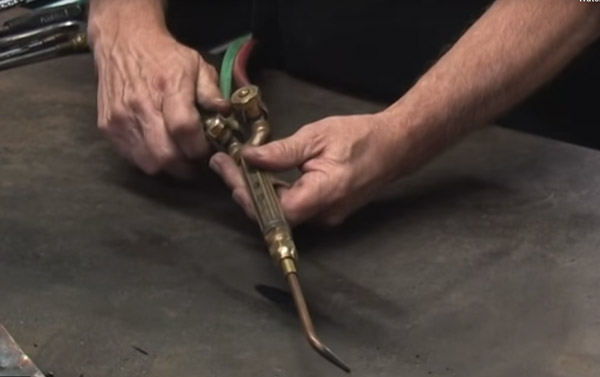
- Make a note where needles are on the fuel pressure regulator on the oxyacetylene tank and the oxygen tank that shows you the contents of each tank
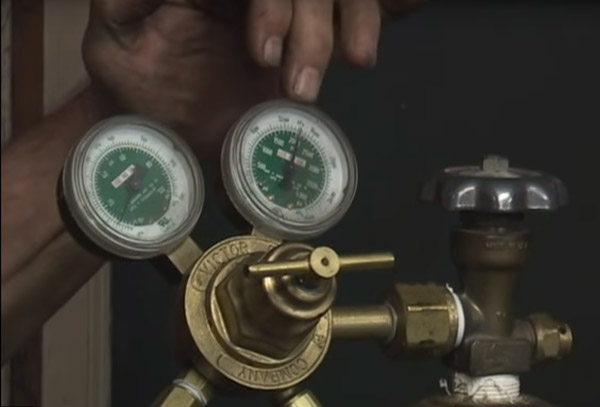
Checking the content levels on the oxyacetylene and oxygen tanks - Next turn the tanks off (leave the pressure adjustment screw/knob where it is)
- Check the needle on the content gauges of the regulators and write down the levels.
- After an hour re-check the regulators. The needle will either be in the same place showing there are no leaks, or the needle dropped down a bit (showing a slow leak) or the needle drops down a larger amount, showing a larger leak.
- Next, if you find you have a leak, you need to determine where the leak is. Use some dish washing liquid in a bit of water and use it to go over all of the fittings. If you brush some on and see bubbles then you have a lead. If you see bubbles tighten the screw.
Sealing Joints
The easiest way to seal a joint is with sealing tape. If there is a bit of oil then you might not achieve a tight seal.
As an alternative, you can try a liquid called “thread seal.”
Blowback and Flashback
Video: Flashback Arrestor
Blowback occurs when the oxygen levels get low or empty, causing the gases to reverse their flow. This is why it is important to purge hoses or they could result in an explosion in the regulator, cylinder or hose.
A flashback occurs when a backfire happens in the mixing chamber. Sometimes workers fail to close the oxygen valve, the flame burning in the head of the torch could ignite gasses in the hoses and cause flashback. The explosion moves through the torch, hose, regulator and cylinders. It can result in a burst hose or an explosion of the regulator or cylinders.
A flashback arrestor and checking the valves can help to prevent these problems.
